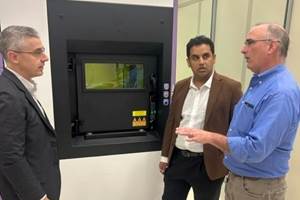Sandvik Osprey HWTS 50 Hot Work Tool Steel Developed for Enhanced Printability
The material offers improved tempering and thermal fatigue resistance as well as thermal conductivity compared to conventional H-class hot work tool steels.
Sandvik’s Osprey HWTS 50 lean hot work tool steel powder was designed for enhanced printability for laser-based additive manufacturing (AM) as well as for hot isostatic pressing (HIP) and metal injection molding (MIM). The material’s tempering and thermal fatigue resistance as well as thermal conductivity are improved compared with conventional H-class hot work tool steels. The company says that these advanced properties effectively address many common challenges in hot-work applications within general engineering.
Osprey HWTS 50 improves the processability in laser powder bed fusion (LPBF), lowering the susceptibility of cold cracking compared with conventional H-class hot work tool steels. Typical applications include high-pressure die casting dies, injection molds and hot forming tools.
The chemical composition is tailored for improved hot hardness at temperatures exceeding 1112°F/600°C. It is characterized by lower carbon content compared to those of medium carbon hot work tool steels and modifications to the carbide forming elements. This is said to ensure a comparable or even enhanced tempering resistance despite lower carbon wt.%.
The thermal conductivity of Osprey HWTS 50 is higher compared to medium carbon tool steels over a wide temperature range. High thermal conductivity is beneficial for applications running at elevated temperatures, such as die casting and forging. It ensures rapid and efficient heat dissipation, resulting in faster cycles.
“Additive manufacturing is increasingly being used to produce tools and dies with near-surface conformal cooling channels,” says Faraz Deirmina, principal metallurgist in metal powder at Sandvik. “Besides optimizing processing parameters, it is important to develop chemistries specifically tailored for this technology to address fabrication challenges. Osprey HWTS 50 is designed to alleviate these challenges making it highly suitable for tooling applications at elevated temperatures. Examples are hot forming dies, extrusion and injection molding dies, and high pressure die casting dies.”
This metal powder is manufactured by either induction melting under vacuum inert gas atomization (VIGA) or melting under argon prior to inert gas atomization (IGA), producing a powder with a spherical morphology which provides good flow characteristics and high packing density. In addition, the powder has a low oxygen content and low impurity levels, resulting in a metallurgically clean product with enhanced mechanical performance.
With the alloy design philosophy in HWTS 50, using computational tools as well as a leaner chemical composition, Sandvik says it is aiming to drive the shift toward a more sustainable future. By using leaner compositions optimized through computational tools, users can increase resource efficiency and extend the lifetime of components, which in turn reduces energy consumption and CO2 emissions. Additionally, computational tools enable faster and more eco-friendly alloy development with optimized chemistries, outperforming traditional trial-and-error methods.
Key Characteristics:
- It offers improved processability in LPBF, reducing cold cracking compared to conventional hot work tool steels.
- The material has an optimized chemical composition for improved hot hardness, tempering and thermal fatigue resistance. It also has a lower carbon content and modified carbide-forming elements to ensure comparable or improved tempering resistance.
- It features thermal conductivity with approximately 35 W/mK at room temperature, providing excellent performance in high-temperature applications such as die casting and forging.
- Depending on the tempering temperature, a hardness range of 40 to 50 HRC in combination with excellent tensile and impact properties can be achieved, ensuring the longevity and durability of molds and dies under high-stress conditions.
Key application areas:
- Mold making: Injection molds
- Extrusion dies: Mandrels and cores
- Hot forging: Dies and components
- Die casting tooling: Hot gripper dies and related components
- Plastic molding: Molds and dies
- Tool holders: Various tooling applications.
- Mold repair: Rebuilding die casting molds via direct energy deposition (DED)
Related Content
Two 12-Laser AM Machines at Collins Aerospace: Here Is How They Are Being Used
With this additive manufacturing capacity, one room of the Collins Iowa facility performs the work previously requiring a supply chain. Production yield will nearly double, and lead times will be more than 80% shorter.
Read MoreNew Zeda Additive Manufacturing Factory in Ohio Will Serve Medical, Military and Aerospace Production
Site providing laser powder bed fusion as well as machining and other postprocessing will open in late 2023, and will employ over 100. Chief technology officer Greg Morris sees economic and personnel advantages of serving different markets from a single AM facility.
Read More8 Cool Parts From Formnext 2023: The Cool Parts Show #65
New additive manufacturing technologies on display at Formnext were in many cases producing notable end-use components. Here are some of the coolest parts we found at this year’s show.
Read MoreVulcanForms Is Forging a New Model for Large-Scale Production (and It's More Than 3D Printing)
The MIT spinout leverages proprietary high-power laser powder bed fusion alongside machining in the context of digitized, cost-effective and “maniacally focused” production.
Read MoreRead Next
Profilometry-Based Indentation Plastometry (PIP) as an Alternative to Standard Tensile Testing
UK-based Plastometrex offers a benchtop testing device utilizing PIP to quickly and easily analyze the yield strength, tensile strength and uniform elongation of samples and even printed parts. The solution is particularly useful for additive manufacturing.
Read MoreCrushable Lattices: The Lightweight Structures That Will Protect an Interplanetary Payload
NASA uses laser powder bed fusion plus chemical etching to create the lattice forms engineered to keep Mars rocks safe during a crash landing on Earth.
Read More3D Printed Polymer EOAT Increases Safety of Cobots
Contract manufacturer Anubis 3D applies polymer 3D printing processes to manufacture cobot tooling that is lightweight, smooth and safer for human interaction.
Read More





















